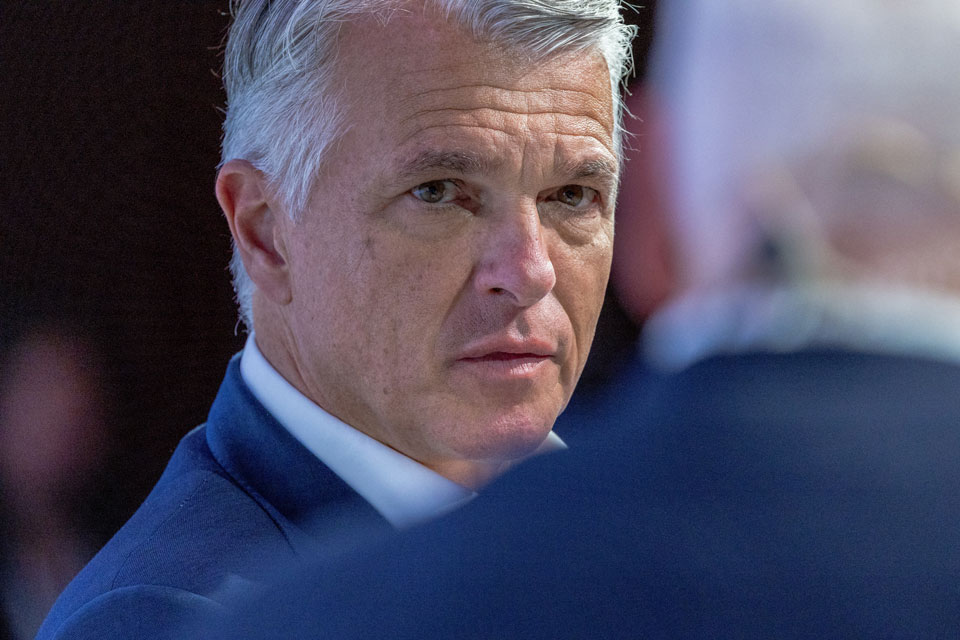It is one of the biggest banking takeovers in history and has been described since day one, notably by executives leaving the target, as banking’s deal – perhaps even steal – of the decade.
UBS’s capital strength, sound liquidity, admired strategy and good management allowed it to pick up its Swiss rival Credit Suisse 11 months ago for a bargain.
At first, things progressed quickly. UBS was soon able to stem deposit flight from its troubled acquisition, recapture and then retain client assets.
When it announced fourth-quarter and full-year 2023 results on February 6, UBS reported net new assets of $77 billion since the acquisition, with $22 billion coming in the final quarter driven by inflows from Asia Pacific, the Americas and Switzerland, partly offset by outflows in Europe, Middle East and Africa.
UBS management was confident enough to volunteer an early exit from the loss-sharing arrangement it had negotiated with the Swiss government and to pay down emergency liquidity.
It was also quick to make $4 billion of cost cuts, as a down payment on the $13 billion of annual savings it expects to take out by the end of 2026, up from a first estimate of around $10 billion.
It had already shed 17,000 jobs from what the two banks’ totals were at the start of 2023.
But the shares were down 7% following the latest update, perhaps because investors that have bid the stock price up by 24% in the past six months are finally coming to accept just how tough it might be to integrate two global systemically important banks, while still running them both and restructuring the one that, in the words of chief executive Sergio Ermotti, had suffered from many years of unsustainable capital allocation and underinvestment in its business and control frameworks.
Net new assets
Of course, it had another vulnerability that is not talked about so much.
“Name me another bank that drew the majority of its deposits from outside its home market,” one investor invites Euromoney.
UBS hopes that it can continue to win $100 billion of net new assets through the next three years of restructuring before then ramping up to $200 billion a year and building a $5 trillion wealth management business by 2028 with better margins than it has today, notably in the US.
But much remains to be done. The legal entities won’t be merged until the end of the first half of 2024, when UBS expects also to have a new US intermediate holding company. Until that happens, the bank cannot rush to migrate clients or decommission legacy platforms.
So, cost cutting may now slow down and be phased in slowly until the end of 2026, even if it might eventually exceed original targets.
Part of the price of doing the integration well will likely be lower revenues and profitability during the next two to three years of hard graft
Part of the price of doing the integration well will likely be lower revenues and profitability during the next two to three years of hard graft.
But if UBS manages that well, it might eventually produce better returns on risk-weighted assets – by foregoing revenue from risky Credit Suisse clients that came to the bank for fewer products and services, and reallocating financial resources elsewhere – as well as higher returns on common equity tier-1.
Ermotti told analysts desperately trying to update their earnings models through a two-hour call dense with numbers and jargon: “While we will sacrifice some reported profitability and growth in the short term, we are convinced this will improve the quality of our long-term growth trajectory and bring greater cost and capital efficiency.”
Management reiterated targets to realize an underlying return on CET1 capital of around 15% and a cost-to-income ratio of less than 70% at the end of 2026. Even more enticingly, they held out the prospect of around an 18% return on equity by 2028.
By then the projected growth in net new assets each year, if realized, will be equivalent to adding a business the size of Credit Suisse in 2023.
Costs before benefits
Ermotti doesn’t want investors to talk about this as a restructuring story, because a poorly run bank is being taken over by a well-run one. Credit Suisse brings new clients in Asia and Latin America, as well as an enlarged investment banking capability that might boost margins in UBS’s US wealth-management business that for now lag peers.
But as with any restructuring, the loss of earnings is felt before the benefit from cost savings, which are themselves expensive to secure.
If UBS is lucky, the investment bankers coming on board from Credit Suisse might arrive at the right moment to profit from a return to normal investment banking activity levels, of which the first glimmers are just now appearing.
But return on CET1 is only expected to be in the mid single digits this year and high single digits in 2025. Analysts at Citi point out that the downside risk to near-term consensus earnings has led some investors to query the reliability of the long-term targets, as there is now expected to be more of a hockey stick trajectory than was previously thought.
That might not hurt the share price unduly, as many investors are already looking through the integration to the years after 2026.
Citi says that “UBS has become a ‘concept stock’.”
The concept is the familiar one: jam tomorrow.




